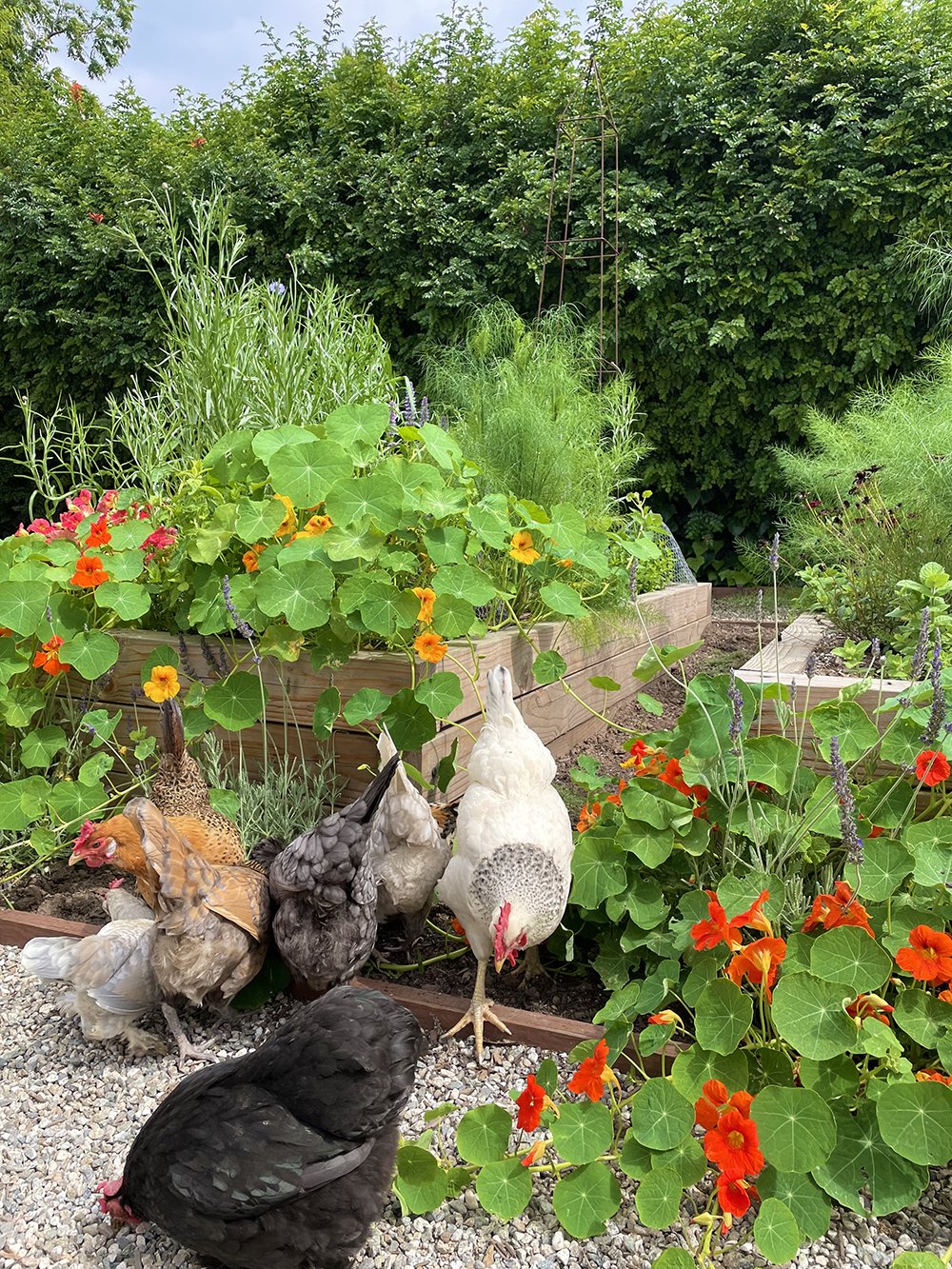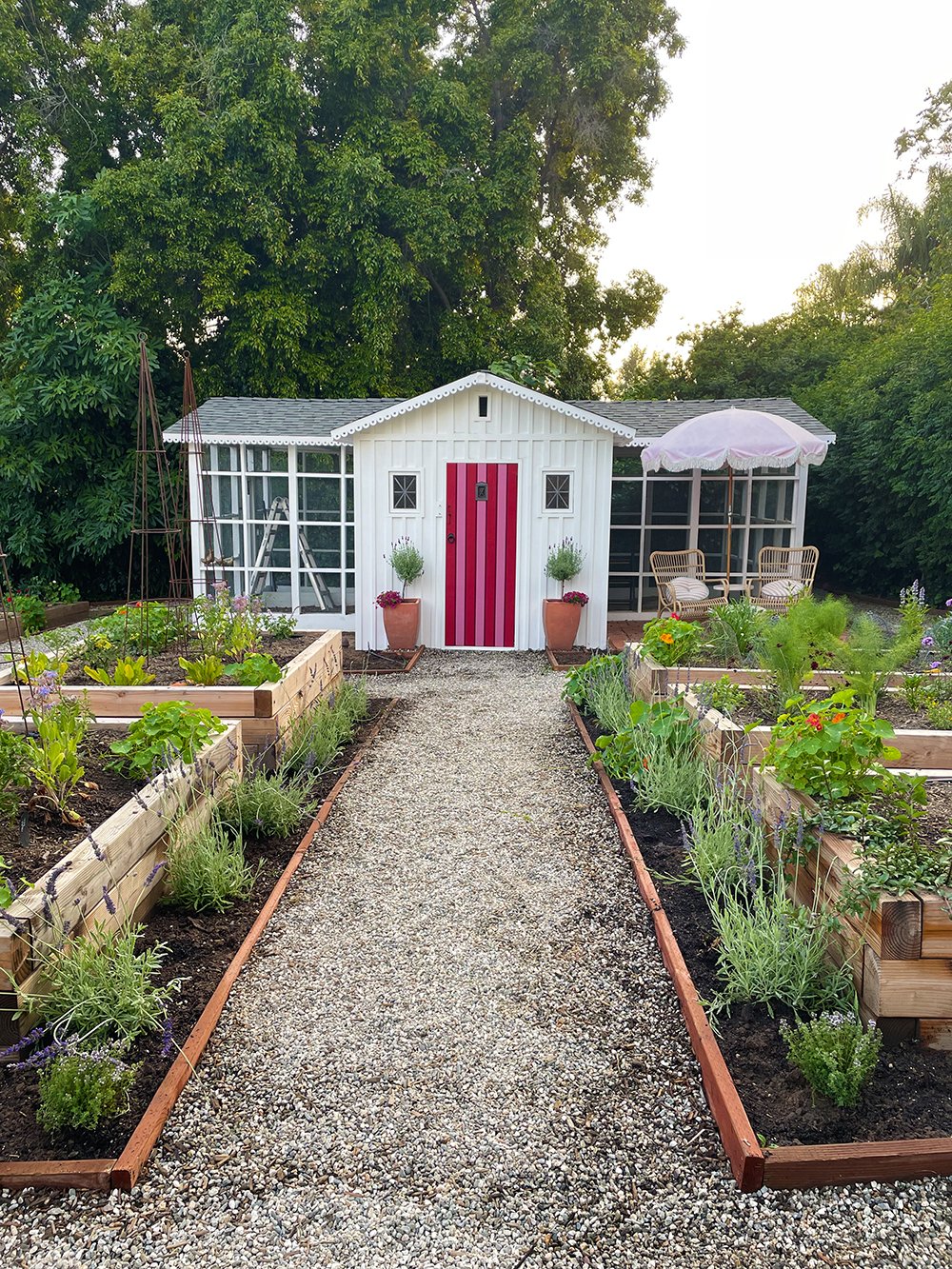How I Garden with Chickens
This post is brought to you in partnership with Gardener’s Supply Company and includes affiliate links.
There is no single garden-related question I get more than: How do you keep your chickens from destroying your garden?
And I get this question ALAWT.
Because if you have chickens, you know the struggle. They can turn a luscious garden into a post-apocalyptic hellscape in 15 minutes flat. So why do we all still try? Why do we all seem to want our chickens to coexist with our garden when we know—WE KNOW DEEP IN OUR SOULS—they only crave destruction? I don’t have the answer to the why, but I’ve managed to figured out a pretty decent how.
For me, a successful chicken-garden integration boils down to a combination of three essential practices:
Supervision
Utilizing protective garden structures
Redirection
First things first: SUPERVISION. I cannot stress this enough. If you think you’re going to let your chickens free-range all day in your garden and it’s going to remain a garden, bless your heart. And maaaaaaybe if you’ve got a very old-growth, established garden, you might be able to get away with this. But if you’ve got a new or seasonal garden, you’ve got to keep your looking balls on your chickens in order for your precious young green things to have even a fighting chance of survival. And let’s be honest—we don’t want our gardens to just barely get by, we want them to flourish!
If you want your chickens to free-range unsupervised all day, you simply MUST give them a separate free-range area away from your garden (incidentally, this is what we did at our old house: we had our GARDEN garden, and we had a separate chicken garden. I’d let the chickens free-range in the actual garden only with strict supervision).
The second important part of my chicken garden process is that I like to make use of protective and decorative garden structures wherever possible. This includes fencing, cages, cloches, and even decorative trellises, obelisks, and towers. I find that anything immobile amongst the plants goes a long way towards discouraging those little maniacs from digging, which is by far their most destructive behavior.
Some of my absolute favorite products for this use come from the Gardener’s Supply Company Chicken Wire Collection. I have been using the Chicken Wire Cloches from Gardener’s Supply Company for years and years and have always been a huge fan! Not only are the cloches so cute in the garden, they are absolutely ideal for protecting vulnerable young plants and seeds, and are super versatile and easy to move about as needed. And they hold up—as I said, I’ve been using mine season after season for years! Recently Gardener’s has expanded the product line with fencing, new cages, domes, trellises and more, and they gifted me with a few of these fabulous products to try out. The Expandable Row Cloche System is ideal for row crops, and totally expandable (duh, Kate, it’s in the name, thanks) to fit your garden requirements perfectly. Which is especially nice when you are like me and keep changing your mind about how long you want your crop rows to be. And I get an extra kick out of watching my chickens cruise along the top of it like it’s a special catwalk just for them. Gardener’s also sent me one of their new Crop Coops and I am absolutely smitten. It is huge (and even has an additional extension you can get to make it twice as tall), and fits nicely across raised garden beds. These products have become a pivotal in my garden!
The Chicken Wire Expandable Row Cloche system and the Chicken Wire Cloches with Extensions (foreground) are absolutely essential in keeping newly planted seedlings safe from those dang chicken beaks.
The same view of the garden only a few weeks later with sunflowers and artichokes successfully grown beyond the seedling stage with the help of the Gardener’s Supply Company protective cages.
The Crop Coop makes a nice garden perch.
Another favorite cloche variation is the 3-in-1 Chicken Wire Cloche which can be configured to lay flat on the ground as shown, as well as into a tall, upright cage, or split into two separate half cloches (if you want to place them against a wall or garden bed).
Chicken wire cloches and Crop Coop in the garden.
The chickens trying their best to find a weak spot in the chicken wire cloches. Spoiler alert: there aren’t any.
The final bit of my gardening-with-chickens process is probably going to be a bit polarizing. It’s also kind of a two-parter. It is what I refer to as “redirection”, and yes, if you’re familiar with puppy training, it’s that kind of redirection. YES CHICKENS CAN BE TRAINED. Or maybe “trained” isn’t the most accurate word—”encouraged” is probably better. When I’m supervising the birds in the garden and they are messing around in a spot I don’t want them to be messing around in, I’ll give a quick squirt of the garden hose in the spot I don’t want them in to get them to move along. LET ME BE CLEAR: I’m not suggesting you actually spray your chickens, rather you squirt the ground nearby. It doesn’t actually scare them, but it does absolutely encourage them to move on.
But there is a very important flip side to this process. If you are going to shoo them away from areas you don’t want them messing with, you MUST give them places in the garden that ARE okay for them to mess with. Redirection. If you give them places to scratch and dig and eat and do all the natural, important, healthy chicken behaviors that they need to be doing, and then consistently shoo them away from the places you DON’T want them doing that, they will naturally learn to prioritize chickening in the right places. See? Chicken training. I swear they learn. Chickens are actually very clever (well, most are….Hi, Corn).
I know what you’re thinking: Well, Kate, if your chickens are so well-trained, why do you need to keep supervising and putting protective barriers around your plants? Because chickens are jerks. They are jerks. Never trust them. While mine pretty reliably stay out of the garden beds I’ve encouraged them to stay out of, if left to their own devices for too long, they’ll eventually rediscover the off-limits spots and have a party. Therefore, supervision and protective structures: STILL IMPORTANT. But the redirection training does help me have to be a little less focused on supervision while I’m in the garden with them. So that maybe I can get a little actual gardening done instead of just staring at chickens all day.
Freshly planted gardens are the most vulnerable to chicken chaos. Don’t turn your back!
The same view of the garden only a few weeks later after implementing my three part system of supervision, protective garden structures, and redirection.
And there you have it: gardening with chickens. It will be fun, they said.
Cheers, friends!
This post is brought to you in partnership with Gardener’s Supply Company and includes affiliate links.























Yes, yes…we sold the house. But let’s tour the before + after of the gardens anyways.